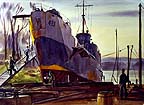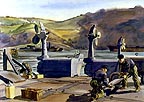 Appledore
Ebb
Appledore
EbbDwight C. Shepler #134
Watercolor, Feb 1944
88-199-EG
Preparations for the Allied invasion of Normandy were unprecedented in scale and complexity. In addition to accumulating hundreds of thousands of soldiers and millions of tons of material in Britain, the Allies gathered hundreds of specialized landing craft in ports across southern England. These would play a critical role in delivering the Allied assault troops to the French beaches. Given the presumed difficulties in seizing French habors from their German garrisons, the Allies designed and built huge metal and concrete artificial harbors--later called "mulberries"--for tow to the Normandy beaches. Once the American and Commonwealth assault troops had secured beachheads in France, the mulberries would make unloading cargo ships easier and faster than carrying supplies over the beach.
 Appledore
Ebb
Appledore
Ebb
Dwight C. Shepler #134
Watercolor, Feb 1944
88-199-EG
The twenty-one foot tide of North Devon withdrew toward the Irish Sea, leaving the confluence of the Taw-and-Torridge a Y-shaped trickle in the flat sands. This was significant, for these tidal and beach conditions approximated those in Normandy where the allied invasion force would land in action. LCTs (Landing Craft Tank) and coasters, which would play a part in the invasion, were left high and "dried out" by the ebb.
Beyond the lighthouse in the distance lay the dunes and surf-swept beaches of the U.S. Army Assault Training Center at Woolacombe. Here a series of small boat crews from the Advance Amphibious Training Base at Appledore-Instow practiced assaults with successive divisions of infantry troops amidst realistic gunfire and bombardment. The principal objective was the long flat beach of Woolacombe, and the "hedgehogs" of its hinterland, a reasonable facsimile of a "certain" piece of the coast of Europe. Time would tell where and when the actual invasion landscape would be encountered.
 Maintenance
– Instow
Maintenance
– Instow
Dwight C. Shepler #133
Watercolor, Feb. 1944
88-199-EF
The retreat of the lofty tides of Appledore left a landing craft high and dry so that a Le Toruneau crane could hoist her stern to exchange a bent propeller. The maintenance shop of Instow Amphibious Base had a great record of keeping busy tank and infantry landing craft operational, despite severe treatment in the surf. The sky reflected a typical winter mood of North Devon.
 The
Battered Amphibian - Darmouth Amphibious
Base
The
Battered Amphibian - Darmouth Amphibious
Base
Dwight C. Shepler #136
Watercolor, March 1944
88-199-EI
An LCI (Landing Craft Infantry), broached in attempting to rescue a sister ship from the rocks during a pratice operations, had her wounds dressed at the Waddleton shipway in the sequestered estuary of the "Dart." U.S. Navy ship fitters welded in new plates. Maintenance and repair of invasion craft constantly in use was an indispensable part of invasion preparations.
 The
Rhino’s Feet
The
Rhino’s Feet
Dwight C. Shepler #128
Watercolor, March, 1944
88-199-EA
Strange symbols of modern amphibious war were the propellers of Rhino barges swung clear of the water across the sterns of two barges. Three of their four-power rise against the Devon hills, while Seabees completed assembly of pontoons.
Rhino barges were 175 feet long and 42 feet wide and constructed of steel and girders. Shallow of draft and capable of carrying huge loads, they served as lighters (supply transport boats) for delivering their cargo on flat beaches, one of the great problems of the European invasion. Self-propelled, they made their ungainly way with their decks loaded with an incredible quantity of tanks, trucks, jeeps and the infinite paraphernalia of combat.
 Phoenix
Rising
Phoenix
Rising
Dwight C. Shepler #156
Watercolor, April 1944
88-199-FD
With the complex of floating breakwaters, the sunken block ships and concrete Phoenix units made up most of it. This view of the great floating dry dock at Portsmouth, England, shows the underwater shape of the Phoenix units which were towed slowly at three to four knots across the English Channel.
The "Mulberry" artificial harbor was invented in England and its units were built in Scotland and England. The "Mulberry" was designed to provide a harbor on a coast which had no such natural features. This was critical to the continued arrival and unloading of military supplies and reinforcements from England following the establishment of the D-Day beachhead. Mulberry ‘B’ was the British harbor, while Mulberry ‘A’ served the American landing beaches. British Royal Engineers and U.S. Navy Seabees had the tough assignment of assembling the breakwater and piers on the Normandy side of the British Channel. The whole project was considered to be one of the boldest flights of imagination in history. Note the little window of the crew’s quarters for the trans-channel cruise.
 Phoenix
Afloat
Phoenix
Afloat
Dwight C. Shepler #157
Watercolor, March 1944
88-199-FE
One of the great concrete sections of the main breakwater for a "Mulberry" floated at a fitting-out basin. Its hull of hollow and compartmented concrete, reinforced with tons of steel, had valves which permitted internal flooding as tugs nudged the sinking leviathan into its place in the breakwater of the man-made harbor on the Normandy coast.
The outermost auxiliary element of the "Mulberry" harbor was a line of floating breakwaters. These were long steel floats, cruciform in cross-section. They were moored to the bottom and so sluggish in buoyancy that they barely showed above the surface. They knocked down and absorbed the force of the seaward swells before they reached the main breakwater composed of phoenix units and block ships.
 Pierheads
for Mulberry "A"
Pierheads
for Mulberry "A"
Dwight C. Shepler #155
Watercolor, 1944
88-199-FC
Within the shelter made by the floating breakwaters, the sunken block ships and the concrete Phoenix units, these pierheads rode up and down with the tide. From the pier heads floating on reinforced concrete pontoons, a bridge-like causeway made a roadway to the beach. Large ships were able to unload vital military supplies and troop reinforcements without running aground.
This part of the man-made harbor was a mammoth towing job for the tugs. Its Seabee ensigns and crews had all the pride of battleship sailors in their strange craft of 1944.
Seabees and Royal Engineers are depicted completing the installation of "spuds" in one pierhead while another loomed large in scale in comparison with the two old British battleships in the background.
 When
Is "D" Day?
When
Is "D" Day?
Dwight C. Shepler #132
Watercolor, April 1944
88-199-EE
Off-duty small boat sailors and an army sentry are shown discussing the principal question on the minds of Allied soldiers and sailors. The Allied High Command held the actual landing date in greatest secrecy, and many Allied troops did not know if they were going on the actual D-Day landing or yet another training exercise until they boarded the ships. Allied forces in Britain lived in uncertainty, knowing the orders could come at any time.
1 2 3 4 5 6 7 8 9 10 11 12 13 14 15 16 17 18 19 20 21 22 23 24 25
1 July 2001